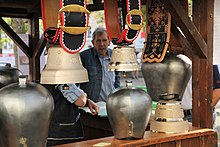Tryelte
Tryelte ( [ˈtriːçəln] , Swiss German [ˈtriːχlə] ; also Trychlen, Tricheln, Treicheln, Treichlen, Trychlä, Tringele, Trinkele ) is a Swiss (high) German word for «cattle / cow bells , -schellen» (dialectal Swiss German in singular and Plural Trychle and the like). As an activity, tryeling is a custom that can be found in various forms in the northern Alpine region . Some variants are presented here as examples.
Trychle versus Bell
A Trychle or Treichle always consists of hammered sheet metal. In contrast, a bell is made of cast metal. This makes the Trychel sound more clattering than the sound of a bell; However, due to this construction, a trychle is also much lighter than a bell of the same pitch and therefore easier to carry over longer distances.
Word origin
The noun Highest Alemannic German Trychle [triːχlə] or High Alemannic German Trinkle, Tringg (e) le, Tringele, Treichle [trɪŋkχlə], [trɪŋk (ə) lə], [trɪŋələ], [treɪχlə] occurs only in the extreme southwest of the German language area ( Southern Black Forest and German-speaking Switzerland without their northeast) and means herd bell or cattle bell. The word has been well documented since the early 16th century, an even older diminutive drinkilken is documented from Old High German times; the original origin, however, remains unclear. The variance of the sound reflects Staub's law . For linguistic and cultural-historical details see the word article Trinkele n in the Swiss Idiotikon .
Haslital tryeln
Every year, drums are struck in the Haslital and large cattle bells and bells are rung in order to scare away evil spirits on the longest nights of the year. The old year's week extends from midnight on 25/26. December to the last working day of the year, which is called Ubersitz (Übersitz) and must not fall on a Sunday. During the Trychel week, Trychel trains come to Meiringen from the surrounding villages of the Haslital . After measuring the bells, which are sorted according to size and sound, the Trychel train starts moving and trieschelt up and down the streets of Meiringen in slow step for hours, with drummers sometimes beating the beat in front. At the Ubersitz, the highlight of the week, many Trychlers dress up. On a train there is a giraffe-like member known as a Schnabelgeiss, whose role is to frighten the audience. In some trains there is also a so-called "Huttewybli" ('female with a hat'), which is heavily bent under the weight of her husband, who is sitting in the hat (back basket), running through the streets and clearing the way for the Trychel trains. For the Eisenbolgnern, who make their masks exclusively from natural materials, the so-called root mandli runs ahead and clears the way for the train. When a Trychel train goes into a restaurant, it tricks until all the Trychlers are in the restaurant, which creates a deafening noise. Tryeling is a tradition that numerous tourists line the roadsides for.
Einsiedeln
In Einsiedeln , tryeling is common during Carnival . The Trychlers tie a clamp around their belly using a wide leather strap. The Trychel is carried on the back, which is why the dialect also speaks of so-called «Füdlitryelte». The Trychlers march in groups through the village, where they let the Trychels sound in rhythmic unison. To see this tradition on Epiphany , on Schmotzigen Thursday , at Güdelmontag ( Rose Monday ) and Shrove Tuesday. In this context, reference should be made to the carnival figures “ Trichler ”, “ Ustrichler ” and “ Johee ”.
Aegerital
In the Aegeri valley, trotting takes place mainly during the custom of the Chlauseslä. The Santa Claus, the children on the eves of St. Nicholas visited 6 -day December, is accompanied-Chlöpfern Geisslä of Iffeln, Trychlern and. During December 4th and 5th, twelve groups (all unmarried men) with up to 40 Trychlers are out and about in the Ägeri area. Every 6 years there is a big parade, which all groups present themselves.
Further use
In general, trychles are used as a sound instrument on a wide variety of occasions in large parts of Switzerland. Without going into regional festivities and customs, these are: Federal Scheller and Trycher meetings , pageants of all kinds, St. Nicholas / Samichlaus , New Year's Eve (according to the old and new calendar), Carnival , sports events , etc.
See also
- Bell jar
- New Year's Eve , Appenzell tradition with the use of trychels
- Chalandamarz , Graubünden tradition with the use of trychi
Web links
- Audio samples: Edelweisstrychler (see “Soundtrack”) from the Entlebuch
- Schnabelgeissen in Ottenbach ZH : Spraggelen
- Official website of the Carnival Society Goldmäuder, Einsiedeln, with a description of the carnival figures
- Ägeri-Bärgtrychler with customs and Trychle information
proof
- ↑ Schweizerisches Idiotikon, Volume XIV, columns 1183–1189, article Trinkele n I , then columns 1189–1198 numerous compositions and derivations.



